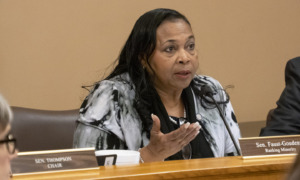As any high schooler can tell you, finding paid work experience in today’s economy can be a real challenge. But youth with disabilities in the juvenile justice and foster care systems face a particularly difficult road. In addition to the challenges of system involvement, youth with disabilities often encounter discriminatory attitudes or hiring practices when searching for a job, and they may need additional supports, workplace accommodations or specialized training to secure and maintain employment.
 These added hurdles dramatically hinder these young people’s chance of success; research shows that youth and young adults with disabilities are employed at less than half the rate of their nondisabled peers.
These added hurdles dramatically hinder these young people’s chance of success; research shows that youth and young adults with disabilities are employed at less than half the rate of their nondisabled peers.
The good news is that there is now a federal policy that could help remove some of these impediments. Under the Workforce Innovation and Opportunity Act (WIOA), each state’s vocational rehabilitation agency must set aside at least 15 percent of its federal funds to provide “pre-employment transition services” to students with disabilities. The services required under the statute include:
- Job exploration counseling;
- Work-based learning experiences;
- Counseling on post-secondary programs;
- Workplace readiness training; and
- Instruction in self-advocacy.
But what do these legal requirements mean for youth in practice?
“Now, vocational rehabilitation agencies have to provide actual work experience and activities while a kid is still in school,” explained Joe Cipolla, director of employer services at JEVS Human Services. JEVS is one of the first providers in Philadelphia to begin a pre-employment transition services program under WIOA. We spoke with Joe and his colleague Sarah Hollister about their experiences designing and launching the program. They explained that JEVS is using WIOA funding to offer three key services to youth in several Philadelphia schools:
- Group training in work readiness and self-advocacy skills;
- Job shadowing, where students observe workers doing jobs during the school day; and
- Paid internships in one to three work areas of interest to the student.
These services function as a package, Joe explained, “taking a youth from ‘here’s how to think about work,’ to ‘let’s look at some things you’re interested in,’ and finally to ‘let’s get you a position doing that.’”
 Joe and Sarah identified several innovative approaches they have been able to take because of the new WIOA funding. “One of the exciting things about the program is that the paid work experiences are so customizable,” Sarah explained, describing how, through the JEVS program, a student who had an interest in event planning was able to get paid for her work helping to plan the prom for the JEVS E3 Center.
Joe and Sarah identified several innovative approaches they have been able to take because of the new WIOA funding. “One of the exciting things about the program is that the paid work experiences are so customizable,” Sarah explained, describing how, through the JEVS program, a student who had an interest in event planning was able to get paid for her work helping to plan the prom for the JEVS E3 Center.
Joe also emphasized the potential power of the collaboration between the school district, private providers and the vocational rehabilitation agency. It takes a new level of coordination among these entities to ensure program success, which “really expands the options available to students,” he explained. By combining the school district’s educational expertise with providers’ connections to employers and community resources, students can receive more integrated and holistic career and academic services.
Although the pre-employment transition services opportunities made possible under WIOA are not specific to youth in foster care or the juvenile justice system, programs could be designed to target those groups. A majority of system-involved youth have some sort of disability and are likely eligible for the services. WIOA also incentivizes states to design workforce programs that reach high-risk youth, including those in the child welfare or juvenile justice system.
Here are some recommendations from our report for how pre-employment transition services programs could better reach system-involved youth:
- Create a clear, written process for identification, referral and service provision for youth in foster care or the juvenile justice system.
- Develop a pre-employment transition services program in a juvenile justice or child welfare facility.
- Incorporate referrals to the vocational rehabilitation agency into the transition planning and reentry processes.
The passage of WIOA won’t mean the end of every struggle that a student with a disability in foster care or the juvenile justice system ever faces. But with the grit these youth so often exhibit, and these new resources for programs who assist them, this new policy can take one hurdle out of their way.
Elisa Egonu is a legal intern and Karen U. Lindell a staff attorney for the Juvenile Law Center.
This is one in a series of blog posts from the Juvenile Law Center on career pathways and barriers for system-involved youth. It is reposted with permission. See the original and full series here.
































